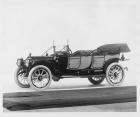|
Re: Miss at Idle
|
||||
|---|---|---|---|---|
|
Home away from home

|
One method I have used to locate intake manifold leaks was to spray wd40 on the joints while the engine is at idle. Theory is the idle will change when you spray on the spot where the leak is. I did this on a slant 6 years ago that was a 'driver' I don't think it would make too much mess on a clean packard engine since most of the wd40 (or some light spray oil) evaporates pretty quickly. I don't know how else or a better way you can 'KNOW' where your intake is leaking.
Posted on: 2013/3/13 11:28
|
|||
|
1953 Clipper Delux Club Sedan, 1953 Caribbean, 1969 912, 1990 Miata
|
||||
|
||||
|
Re: Miss at Idle
|
||||
|---|---|---|---|---|
|
Forum Ambassador

|
Tobs, good method, it's a "classic".
Posted on: 2013/3/13 11:40
|
|||
|
||||
|
Re: Miss at Idle
|
||||
|---|---|---|---|---|
|
Home away from home

|
Just for kix, it's ez enuf to try, advance the timeing to at least 8 degrees (i assum u are running at spec 6). Regardless, try advancing the timing. If that doesn't work then try retarding back to say 4 or even 2 degrees. LOOK FOR inprovement. There mite be internal wear issues with timing gears etc.
Also if trying to idle at very low rpm of say under 550 rpm then try raising the idle speed 100 to 150 rpm. JUst have to play with it. Much of the mfg'er specs for idle and timing is for sales and other corporate benefits. 400 rpm is too low to idle any engine for REAL WORLD operation. Timing specs from nearly all mfg'ers is rather late by at least 2 degrees. It becomes especially ture on engines with much over 40K miles on them. This applies pretty much to ANY engine EVER MADE by ANY mfg'er.
Posted on: 2013/3/13 12:57
|
|||
|
VAPOR LOCK demystified: See paragraph SEVEN of PMCC documentaion as listed in post #11 of the following thread:f
packardinfo.com/xoops/html/modules/newbb/viewtopic.php?topic_id=7245 |
||||
|
||||
|
Re: Miss at Idle
|
||||
|---|---|---|---|---|
|
Home away from home

|
IIRC the SM for the Packard V8 specs vacuum service acceptability range as low as 16 inHg. I personaly doubt that the 16 is any problem at all. Low vacuum can be due to internal engine timing such as gears and chains and their indexing to keys on shafts etc.
Based on what i've read above it sounds to me like u've covered all of the bases for any external problems of 'low vacuum'. The 16 not desireable but probably not a majir issue either. Not likely changing manifold gaskets will help any.
Posted on: 2013/3/13 13:05
|
|||
|
VAPOR LOCK demystified: See paragraph SEVEN of PMCC documentaion as listed in post #11 of the following thread:f
packardinfo.com/xoops/html/modules/newbb/viewtopic.php?topic_id=7245 |
||||
|
||||
|
Re: Miss at Idle
|
||||
|---|---|---|---|---|
|
Home away from home

|
Double checked the V8 manual, p10 of engine section. It indicates 18 to 21. But goes on to say thta reading under 15 indicate problems. I just don;t think the 16 is anything to worry about at this point.
Posted on: 2013/3/13 13:19
|
|||
|
VAPOR LOCK demystified: See paragraph SEVEN of PMCC documentaion as listed in post #11 of the following thread:f
packardinfo.com/xoops/html/modules/newbb/viewtopic.php?topic_id=7245 |
||||
|
||||
|
Re: Miss at Idle
|
||||
|---|---|---|---|---|
|
Home away from home

|
The point about 16inhg vacuum being in the no fault range is well taken considering the possibility of gauge error.
However, as previously noted there is a small leak at #1. That should be addressed. After that the choke stove will leak and cause problems. On the EE-23 Stombergs if there is a leak between the castings that will cut out four whole cylinders (don't ask me why). The idle spec from Packard always bothered me because of low splash and I always set them higher unless specifically requested. Also, the damper can shift and give the wrong timing. Too far advanced will miss. The timing light should be steady and any fluctation the game is over until the distributor is rebuilt and rechecked. As far as the advancing timing on old motors, well the compression doesn't look old to me and given Packard was squeezing every last horsepower out of that engine I would be very suprised if a dyno would demonstrate the need for advancement. In modern cars even small undetectible vacuum leaks will cause problems so I would address what you have already found.
Posted on: 2013/3/13 15:14
|
|||
|
||||
|
Re: Miss at Idle
|
||||
|---|---|---|---|---|
|
Just can't stay away

|
The problem is, I haven't "found" anything. I've run acetylene and propane around the choke stove, the manifolds (#1 no longer has any leaks since I tightened the bolts), the base of the carburetor, the brake booster, the windshield wiper motor, the fuel pump, and basically every vacuum line fitting. Yes, the vacuum is low, but I haven't found any other leaks, and my miss is still there.
When idling, vacuum is 16 in. hg., and very steady.
Posted on: 2013/3/13 17:48
|
|||
|
||||
|
Re: Miss at Idle
|
||||
|---|---|---|---|---|
|
Home away from home

|
Run a road test with the vacuum gauge at various SUSTAINED speeds especialy ove 50 mph on level ground as well as a few down hill grades.
Posted on: 2013/3/13 20:04
|
|||
|
VAPOR LOCK demystified: See paragraph SEVEN of PMCC documentaion as listed in post #11 of the following thread:f
packardinfo.com/xoops/html/modules/newbb/viewtopic.php?topic_id=7245 |
||||
|
||||
|
Re: Miss at Idle
|
||||
|---|---|---|---|---|
|
Home away from home

|
If the miss is steady then it can be sounded out with a tachomter and a screw driver. Ground out each plug until you find the one with the low rpm drop. That is the cylinder causing the problem. If you can't isolate a cylinder then the problem is in the intake or the ignition.
If you really want to see the problem in action find a place that still has an oscilliscope (rots o ruck). The scope will tell you if it is a plug, a lean problem, a running compression problem, or whatever. If the firing line falls off then that is a mechanical problem like a broken or stuck ring. One other note on timing, changing the timing on a short stroke V-8 motor is a lot different that on a long stroke motor like the Super 8 which is more suseptible to piston damage from advanced timing. Packard had the proving grounds and those motors were pretty well set up given what they were. The problem these days is the lack of NOS parts that depresses performance.
Posted on: 2013/3/13 20:19
|
|||
|
||||








